2017 MERCEDES-BENZ E-CLASS ESTATE transmission
[x] Cancel search: transmissionPage 423 of 585

*
NO
TEDama getothev ehicle due to tow‐
ing away incor rectly #
Obser vethei nstruction sand no teson
to wing away. Pe
rm itted towing me thods Ve
hicl eequipment/t owing
me thod Bo
th axle sont heground Fr
ont axle raised Re
ar axle raised
Ve hicles wit hmanual transmission Yes, maximum 50 km at 50 km/h Yes, maximum 50 km at 50 km/h Yes, maximum 50 km at 50 km/h
Ve hicles wit hautomatic transmis‐
sion Ye
s, maximum 50 km at 50 km/h No Yes, if thes teering wheel is fixe din
th ec ent reposition wit hasteering
wheel loc k.
4MATIC vehicles Yes, maximum 50 km at 50 km/h No NoTo
wing wit haraisedaxle: towing should be
per form ed byatow ing compan y. To
wing thev ehicle wit hbotha xlesont he
gr ound #
Obser vethen otes on thep ermitted towing
me thods (→ page419)(→pag e420). 420
Breakdown assis tance
Page 424 of 585

#
Mak esuret hat theb atter yisc onnected and
ch arge d.
When theb atter yisd ischar ged:
R thee ngine cann otbe star ted.
R thee lectric parking brak ecann otbe released
or applied.
R vehicles with automatic transmission: the
automatic transmission canno tbeshiftedto
position iorj.
% vehicles with automatic transmission: if
th ea utomatic transmission cann otbe shif‐
te dtop osition i,ort he multifunction dis‐
pla yint he instrument clus terd oes no tshow
anything, ha vethev ehicle transpor ted
aw ay( →pag e422). Atow ing vehicle wit hlift‐
ing equipment is requiredforv ehicle trans‐
por tation. *
NO
TEDama gedue to to wing away at
exc essively high speeds or over long dis‐
ta nces The driv
etra in could be damaged when tow‐
ing at excessively high speeds or over long
dis tances. #
Atow ing speed of 50 km/h mus tnot
be exc eeded. #
Atow ing dis tance of 50 km mu stnotbe
exc eeded. &
WARNING Risk of accident whe ntow ing
av ehicle whic histoo heavy
If th ev ehicle being tow- star tedort owed
aw ay is heavier than thep ermissible gross
mass, thef ollowing situations can occur:
R thet ow ing eyem aybecome de tach ed.
R thec ar/t railer combination ma yswe rve
or eve noverturn. #
If ano ther vehicle is tow- star tedor
to we da way,its weight mus tnotexc eed th
ep ermissible gross mass of your own
ve hicle. If
av ehicle mus tbetow-sta rted or towe da way,
its weight mus tnotexc eed thep ermissible gross
mass of thet ow ing vehicle. #
Information on thep ermissible gross weight
of thev ehicle can be found on thev ehicle
identification plat e. #
Vehicles with automatic transmission: do
no to pen thed rive r's door or front passenger
door ,otherwise thea utomatic transmission
automaticall yshifts toposition j. #
Fitthet ow ing eye( →pag e424). #
Attach thet ow bar.
* NO
TEDama gedue toincor rect connec‐
tion #
Onlyconnect thet ow ro pe or towb arto
th et ow ing eyes. #
Deactivat ethe automatic locking mechanism
(→ pag e74). Breakdown assis
tance 421
Page 425 of 585
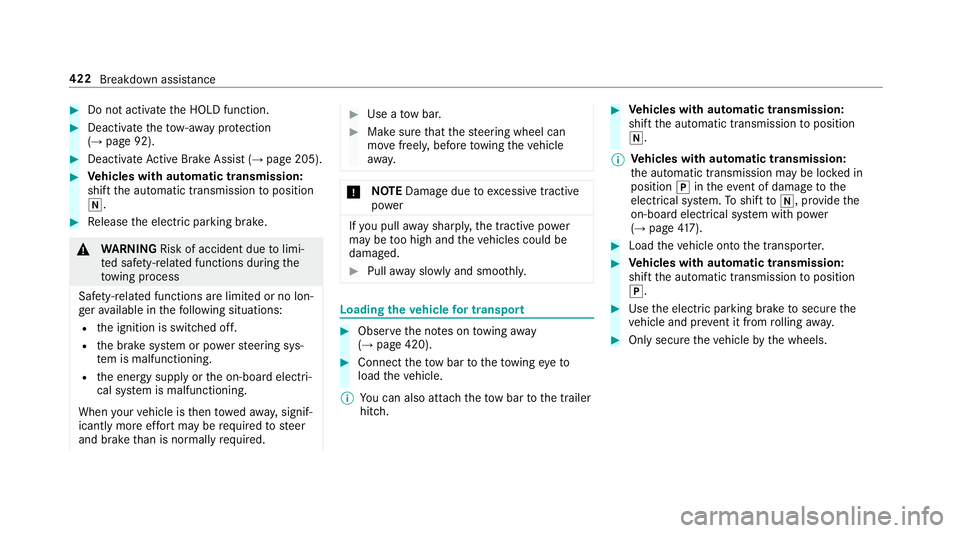
#
Do no tactivate theH OLD function. #
Deactivat ethe tow- aw ay protection
(→ pag e92). #
Deactivat eActiv eBrake Assi st (→pag e205). #
Vehicles with automatic transmission:
shif tthe automatic transmission toposition
i. #
Release thee lectric parking brake. &
WARNING Risk of accident du etolimi‐
te ds afet y-re lated function sduring the
to wing process
Saf ety-re lated function sarelimited or no lon‐
ge ra vailable in thef ollowing situations:
R thei gnition is switched off.
R theb rake system or po wersteering sys‐
te mism alfunctioning.
R thee nergy supply or theo n-boar delectri‐
cal sy stem is malfunctioning.
When your vehicle is then towe da way,signif‐
icantly mor eeffor tm aybe requ ired tosteer
and brak ethan is normall yrequired. #
Use atow bar. #
Mak esuret hat thes teering wheel can
mo vefreely ,befor etow ing thev ehicle
aw ay. *
NO
TEDama gedue toexcessiv etracti ve
po wer If
yo up ullaway sharpl y,thet ractiv epower
ma ybet oo high and thev ehicles could be
damaged. #
Pull away slowl yand smoo thly. Loading the
vehicl efor transport #
Obser vethen otes on towing away
( → pag e420). #
Connec tthe towb arto thet ow ing eyeto
load thev ehicle.
% Youc an also attac hthe towb arto thet railer
hitch. #
Vehicles with automatic transmission:
shif tthe automatic transmission toposition
i.
% Ve
hicles with automatic transmission:
th ea utomatic transmission ma ybelockedin
position jinthee vent of dama getothe
electrical sy stem. Toshif tto i,provide the
on-boar delectrical sy stem wit hpower
( → pag e417). #
Load thev ehicle ont othe transpor ter. #
Vehicles with automatic transmission:
shif tthe automatic transmission toposition
j. #
Use thee lectric parking brak etosecurethe
ve hicle and pr event it from rolling away. #
Onlysecur ethe vehicle bythew heels. 422
Breakdown assis tance
Page 426 of 585
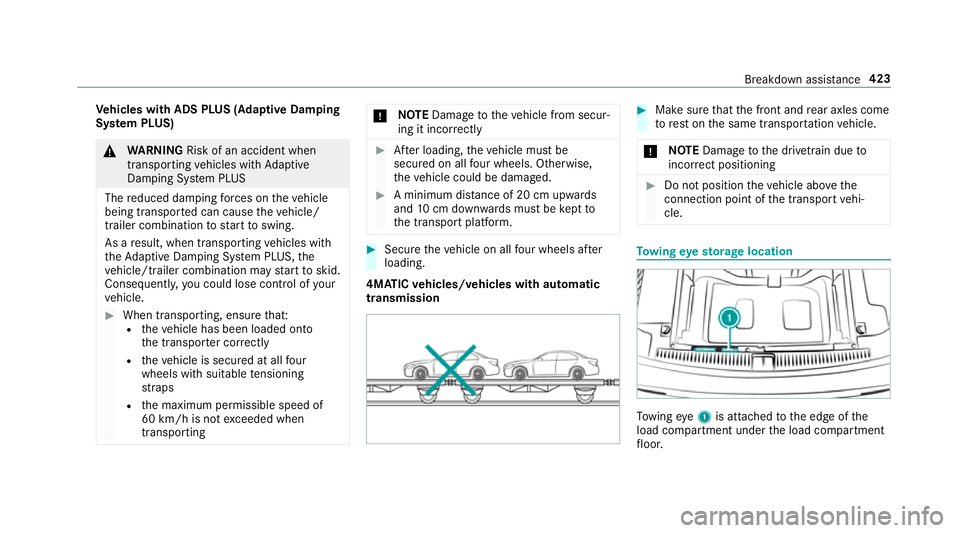
Ve
hicles with ADSP LUS(Ad aptiv eDamping
Sy stem PLUS) &
WARNING Risk of an accident when
transporting vehicles wit hAdaptive
Damping Sy stem PLUS
The reduced damping forc es on thev ehicle
being transpor tedc an cause thev ehicle/
trailer combinatio ntostart to swing.
As aresult, when transporting vehicles with
th eA daptiv eDampin gSystemP LUS,the
ve hicle/trailer combination ma ystart to skid.
Consequentl y,yo uc ould lose cont rolofy our
ve hicle. #
When transporting, ensur ethat:
R thev ehicle has been loaded onto
th et ranspor terc orrectly
R thev ehicle is secured at all four
wheel swiths uitable tensioning
st ra ps
R them aximum permissible speed of
60 km/hisn otexc eeded when
transporting *
NO
TEDama getothev ehicle from secur‐
ing it incor rectly #
Afterl oading, thev ehicle mus tbe
secured on all four wheels. Otherwise,
th ev ehicle could be damaged. #
Am inimum dis tance of 20 cm up wards
and 10cm down wardsm ustbek eptto
th et ranspor tplatform. #
Secur ethe vehicle on all four wheel safter
loading.
4MATIC vehicles/ vehicles with automatic
transmission #
Mak esuret hat thef ront and rear axle scome
to rest on thes ame transpor tatio nv ehicle.
* NO
TEDama getothed rive trai ndueto
incor rect positioning #
Do no tposition thev ehicle abo vethe
connection point of thet ranspor tvehi‐
cle. To
wing eyes torage location To
wing eye1is attached tothee dgeoft he
load compartment under thel oad compartment
fl oor. Breakdown assis
tance 423
Page 427 of 585

Ve
hicles with folding benc hseat: thet ow ing
ey eisl ocated under acove r. Installin
gthe towing eye #
Press them arkonc over 1 inwa rdsa nd
re mo ve. #
Screw inthet ow ing eye clockwise as farasit
willgoa nd tighten. Ve
hicles with atrailert owhitch: vehicles with
at railer hitc hdonothave arear brac ketfor the
to wing eye. Fasten thet ow bar tothet railer tow
hitch.
% Mak esuret hat co ver1engages in the
bumper when your emo vethet ow ing eye.
* NO
TEDama gedue toincor rect us eof
th et ow ing eye When
atow ing eyeisu sedtoreco verav ehi‐
cle, thev ehicle ma ybedamaged in thep roc‐
ess. #
Onlyusethet ow ing eyetot owaway or
to ws tartthe vehicle. To
w- starting thev ehicle (emer gency engine
st arting) Ve
hicles with automatic transmission
* NO
TEDama getothea utomatic trans‐
mission due to tow-starting The automatic transmissio
nmaybe damaged
in thep rocess of tow- startin gvehicles with
automatic transmission. #
Vehicles wit hautomatic transmission
mus tnotbe tow- star ted. #
Vehicles wit hautomatic transmission must
no tbet ow-sta rted. Electrical fuses
Note
sone lectrical fuses &
WARNING Risk of accident and inju ry
due to ov erloaded lines
If yo um anipulat eorbridg eaf aulty fuse or if
yo ur eplace it wit hafuse wit hahigher 424
Breakdown assis tance
Page 444 of 585
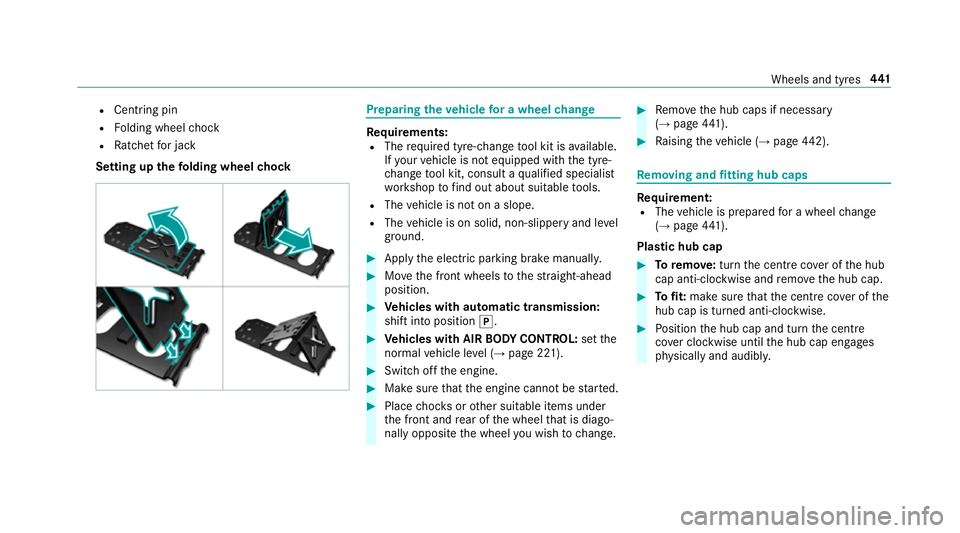
R
Centring pin
R Folding wheel chock
R Ratche tfor jack
Setting up thef olding wheel chock Prepa
ring thev ehicle foraw heelchange Re
quirements:
R The requ ired tyre-chang etool kit is available.
If yo ur vehicle is no tequipped wit hthe tyre-
ch ang etool kit, consult aqualified specialist
wo rkshop tofind ou tabout suitable tools.
R The vehicle is no tonaslope.
R The vehicle is on solid, non-slipper yand le vel
ground. #
Apply thee lectric parking brak emanually. #
Movethef ront wheels tothes traight-ahead
position. #
Vehicles with automatic transmission:
shif tint op osition j. #
Vehicles with AIRB ODYC ONT ROL:setthe
normal vehicle le vel(→pag e221). #
Swit chofft he engine. #
Mak esuret hat thee ngine cann otbe star ted. #
Place choc ks orother suitable items under
th ef ront and rear of thew heel that is diago‐
nall yopposit ethe wheel youw ish tochange. #
Remo vetheh ub caps if necessary
(→ pag e441). #
Raising thev ehicle (→ page442). Re
moving and fittin ghub caps Re
quirement:
R The vehicle is prepared foraw heelchange
(→ pag e441).
Plastic hub cap #
Toremo ve: turnthe centre coveroft he hub
cap anti-clockwise and remo vetheh ub cap. #
Tofit: mak esuret hat thec ent recoveroft he
hub cap is turned anti-clockwise. #
Position theh ub cap and tur nthe centre
co verc lockwise until theh ub cap engages
ph ysicall yand audibly. Wheels and tyres
441
Page 452 of 585
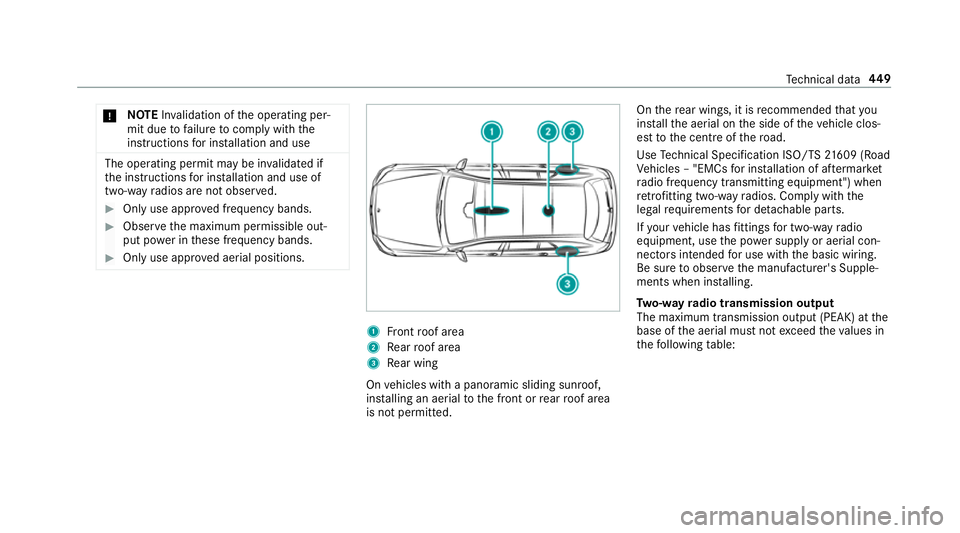
*
NO
TEInva lidation of theo perating per‐
mit due tofailur etoc omply wi th the
instructions fori ns tallation and use The operatin
gpermit ma ybeinvalidated if
th ei nstruction sfor ins tallation and use of
two-w ayradios ar enotobser ved. #
Onlyuse appr oved frequency bands. #
Obser vethem aximum permissible out‐
put po werint hese frequency bands. #
Onlyuse appr oved aerial positions. 1
Front roof area
2 Rear roof area
3 Rear wing
On vehicles wit hapanoramic sliding sunroof,
ins talling an aerial tothef ront or rear roof area
is no tpermitted. On
ther ear wings, it is recommended that you
ins tallth ea erial on thes ide of thev ehicle clos‐
es ttot he centre ofther oad.
Use Tech nica lSpecificatio nISO/T S21609 (Road
Ve hicles –"EMCs fori ns tallation of af term arket
ra dio frequency transmitting equipment") when
re trofitting two-w ayradios. Comply wit hthe
legal requirements ford etachable parts.
If yo ur vehicle has fitting sfor two-w ayradio
equipment ,use thep ower suppl yoraerial con‐
nector sintended foru se wit hthe basic wiring.
Be sur etoobservethem anufacturer's Supple‐
ment swhen ins talling.
Tw o-w ayradio transmission output
The maximum transmission outpu t(PEAK) at the
base of thea erial mus tnotexc eed thev alues in
th ef ollowing table: Te
ch nica ldata 449
Page 453 of 585
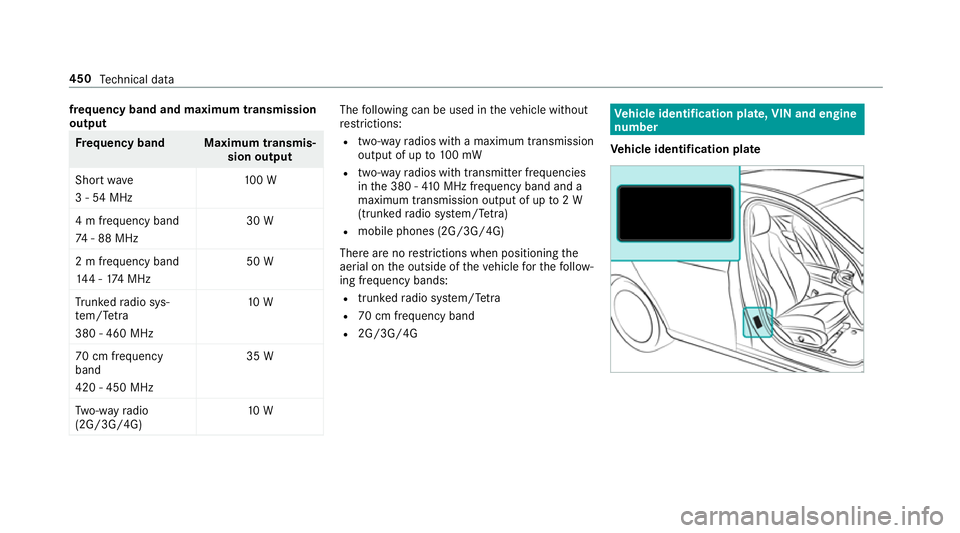
frequencyb
and and maximum transmission
output Fr
equency band Maximu mtransmis‐
sion output
Sho rtwa ve
3-54M Hz 10
0W
4mf requ ency band
74 -88M Hz 30 W
2mf requency band
14 4-1 74MHz 50 W
Tr unked radio sys‐
te m/T etra
380 -460 MHz 10 W
70 cm frequency
band
420 -450 MHz 35 W
Tw o-w ayradio
(2G/3G/4G) 10 W The
following can be used in thev ehicle without
re strictions:
R two-w ayradios wit hamaximum transmission
output of up to100mW
R two-w ayradios wit htransmit terf requ encies
in the3 80 -410 MHz frequency band and a
maximu mtransmissio noutpu tofu pto2W
(trunked radio sy stem/T etra)
R mobil ephones (2G/3G/4G)
Ther eareno restrictions whe npositioning the
aerial on theo utside of thev ehicle fort he follow‐
ing frequenc ybands:
R trunked radio sy stem/T etra
R 70 cm frequency band
R 2G/3G/4G Ve
hicl eidentification plate, VIN and engine
number
Ve hicl eidentification plate 450
Tech nica ldata